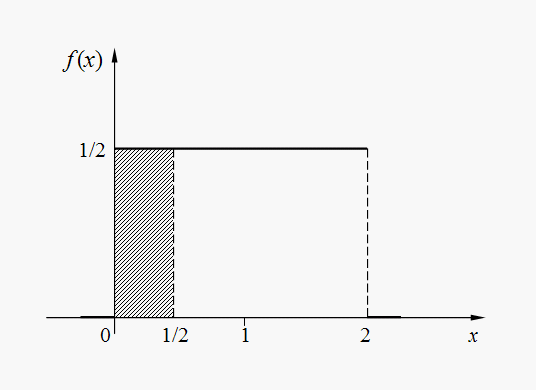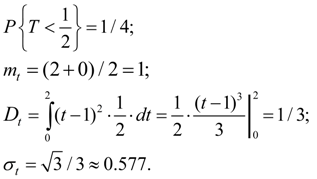|
Examples [2] E x a m p l e 1. Trains of underground go on a regular basis with an interval 2 minutes. Passenger leaves on platform during the casual moment of time which in any way has been not connected with the schedule. A random variable – time Т during which it should wait for a train. Find density function, mathematical expectation, dispersion, average square-law deviation and probability of what to wait to the passenger it is necessary no more half-minute. S o l u t i o n . Density function f ( x ) =1/2 (0 < x < 2) is shown on Fig. 9.
Fig . 9. Density function
E x a m p l e 2. Random variable
X
has exponent distribution with parameter
S o l u t i o n . We have
E x a m p l e 3. The matrix of distribution of system of two random variables X and Y is given by the table:
Find numerical characteristics of system of random variables (
X
,
Y
): mathematical expectations
S o l u t i o n . First we’ll find series of distribution of separate values entering into the system. Summarizing probabilities p ij , being in the 1-st, the 2-nd and the 3-rd lines, we’ll receive:
Series of distribution of random variable X looks like:
Mathematical expectation
From formula (8) dispersion
Average square-law deviation
Similarly summarizing probabilities p ij , being in the 1-st, the 2-nd and in the 3-rd columns, we’ll receive:
Series of distribution of random variable Y looks like:
Mathematical expectation
From formula (8) dispersion
Average square-law deviation
Covariance
Coefficient of correlation:
|
Contents
>> Applied Mathematics
>> Mathematical Statistics
>> Elements of Mathematical Statistics
>> Examples





 thus, between random variables
X
and
Y
there is a negative linear correlation, i.e. at increase in one of them another has decreases.
thus, between random variables
X
and
Y
there is a negative linear correlation, i.e. at increase in one of them another has decreases.